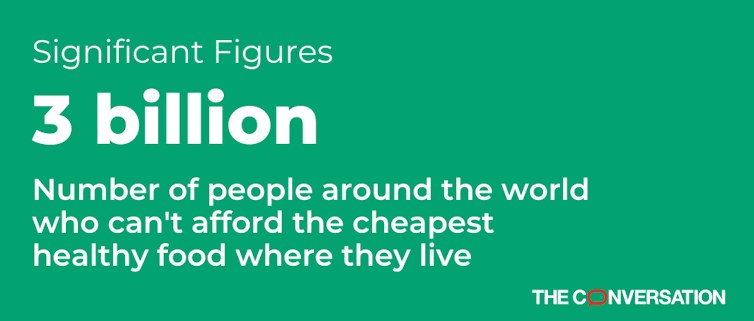3 billion people cannot afford a healthy diet

Eating well takes money – and also time, wise choices, and cooking skills. Nicolas Asfouri/AFP via Getty Images

The COVID-19 pandemic has caused price spikes for corn, milk, beans, and other commodities, but even before the pandemic, about 3 billion people could not afford even the cheapest options for a healthy diet.
A recent analysis of global food price data reveals that as of 2017, the latest available year, around 40% of the world’s population was already forced to consume poor-quality diets by a combination of high food prices and low incomes. When healthy items are unaffordable, it is impossible for people to avoid malnutrition and diet-related diseases like anemia or diabetes.
The remaining 60% of the world’s 7.9 billion people could afford the ingredients for healthy meals. That, of course, does not mean they always eat a healthy diet. Cooking time and difficulty, as well as the advertising and marketing of other foods, can lead many people to choose items that are surprisingly unhealthy.
Distinguishing between affordability and other causes of unhealthy diets is a key step toward better outcomes, made possible by a research project we are leading at Tufts University called Food Prices for Nutrition. The project provides a new view of how agriculture and food distribution relate to human health needs, connecting economics to nutrition in collaboration with the World Bank development data group and the International Food Policy Research Institute.
To measure diet costs globally, our project linked World Bank price data for about 800 popular foods across 174 countries to the nutritional composition of those items. Using the prices and nutritional values of each item, we computed the least expensive way of meeting national dietary guidelines and essential nutrient requirements.
For affordability, we compared diet costs to World Bank estimates of what people typically spend on food and income distribution within each country. It turns out that almost everyone in the United States could afford enough ingredients for healthy meals, such as rice and beans, frozen spinach and canned tuna, bread and peanut butter, and milk. But most people in Africa and South Asia could not acquire enough of these foods for a healthy diet even if they were willing to spend their entire available income.
Food prices go up and down, but many healthy foods like fruits and vegetables, nuts, dairy products, and fish are consistently more expensive than starchy staples, oil, and sugar. The high cost of the healthier food groups often forces people in poverty to eat less expensive items, or go hungry.
What can be done?
Countries can make it possible for everyone to afford a healthy diet by creating more higher-wage jobs and by expanding social protections for low-income people. For example, the U.S. has the Supplemental Nutrition Assistance Program, or SNAP, which helps low-income Americans buy some of the food they need. Safety net programs of this type reduce food insecurity, protect jobs during downturns, and are especially important for child development.
Beyond higher incomes and safety nets for the poorest, food prices can be lowered for everyone through public investment in new technology and infrastructure to improve food production and distribution. Agricultural innovation and investment in food markets can save lives and drive economic development – when the new technologies and other changes are well adapted to local conditions.
We believe that our diet cost data, produced to inform global agricultural policies, gives people sharp new insight into the world food situation. Previous efforts to monitor global food prices focused on tracking a few internationally traded farm commodities, monitoring conditions in places at risk of famine, or keeping an eye on consumer price indices. Measuring the cost of healthy diets using locally available items focuses attention on consumer prices for the healthy foods that low-income people might buy if those items were affordable.
With better data, governments and development agencies can steer their countries to where they want to go, which one day could make it possible for everyone around the world to eat a healthy diet.
World Bank economist Yan Bai contributed to this research.
This article is republished from The Conversation under a Creative Commons license. Read the original article.
Observer Voice is the one stop site for National, International news, Sports, Editor’s Choice, Art/culture contents, Quotes and much more. We also cover historical contents. Historical contents includes World History, Indian History, and what happened today. The website also covers Entertainment across the India and World.

